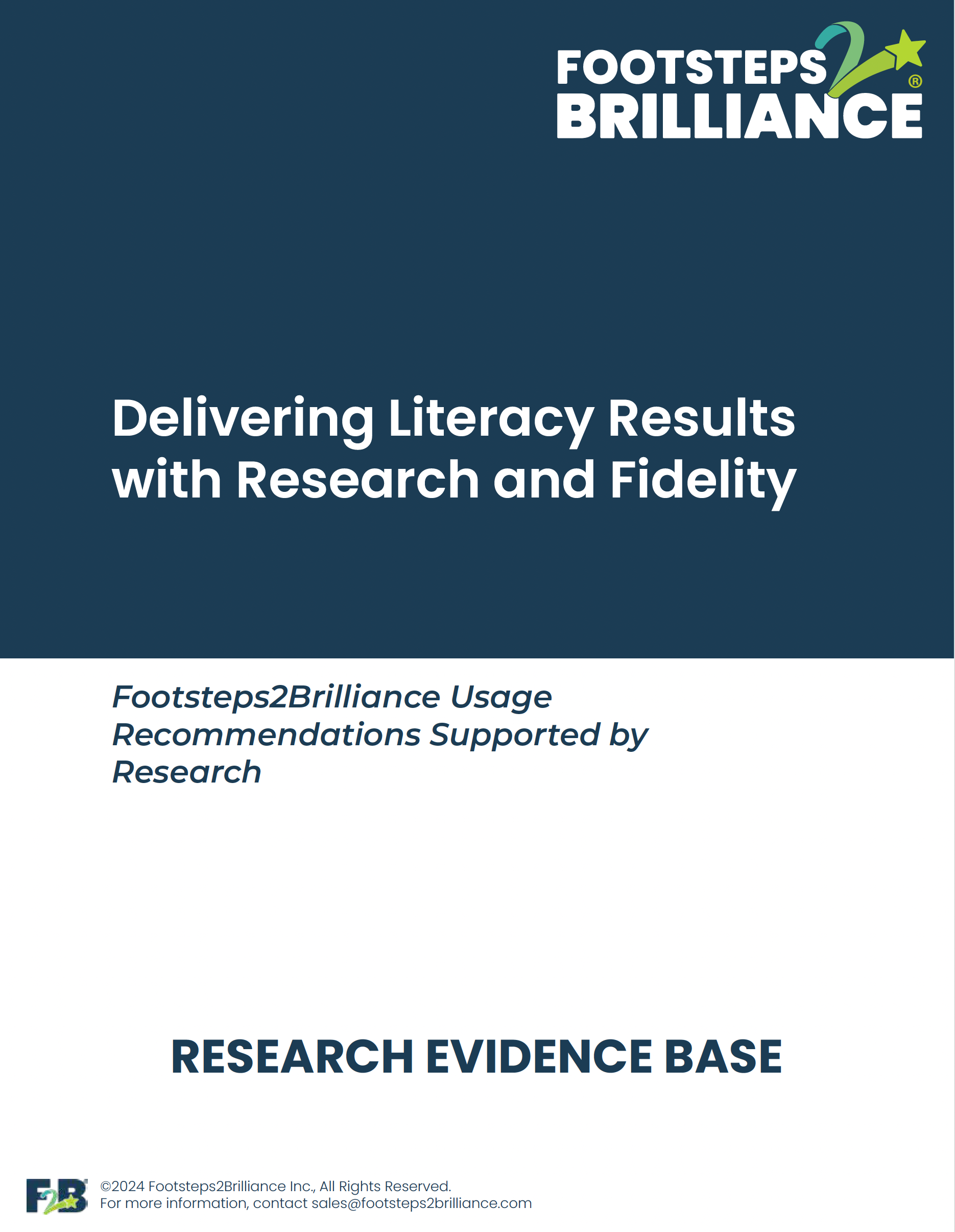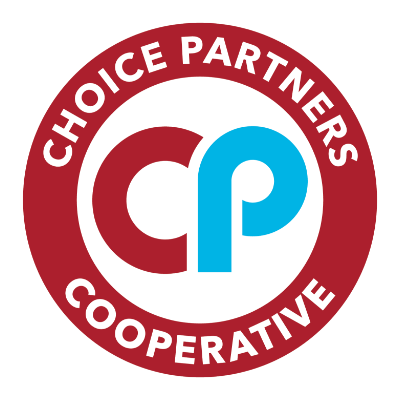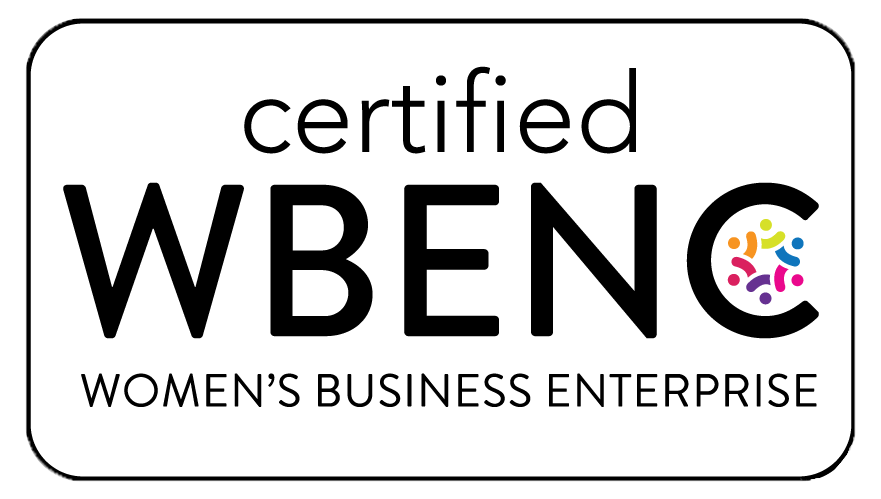Footsteps2Brilliance® Usage Recommendations
The Footsteps2Brilliance® Enterprise App is a bilingual early learning and literacy program designed to supplement and enhance classroom learning while also engaging caregivers to increase instructional time. Several evaluations of the program have noted that increased time on task with Footsteps2Brilliance correlates to higher achievement on benchmark assessments. The more students use the program, the more they learn. Based on this research, Footsteps2Brilliance, Inc., recommends a minimum of 45 minutes of use on the program each week. In order to be developmentally appropriate for young students, this usage goal should be achieved through multiple 10- to 15-minute sessions each week.
The following paper outlines case studies and effectiveness research that support and inform Footsteps2Brilliance usage recommendations.
Higher Use Results in Higher Achievement
Manassas City Public Schools
During the 2015-16 school year, Manassas City Public Schools (MCPS) launched an innovative, blended model of traditional classroom instruction and at-home parent guided learning to service more preschool children. Through a partnership with Footsteps2Brilliance, MCPS provided all children and families within their district with high quality learning whether or not they could attend full-time site-based preschool. While students participated in varying amounts of classroom work, all families used the Footsteps2Brilliance Enterprise App.
A district study examined the PALS™ assessment Fall 2016 results for 453 participating students. The study concluded that 96% of students who used Footsteps2Brilliance for 45+ minutes/week exceeded the 29 points needed on PALS™ to demonstrate Kindergarten Readiness. In fact, children with this high usage on Footsteps2Brilliance achieved 235% of the PALS Kindergarten Readiness benchmark, scoring an average of 68 points. Moreover, further analysis revealed consistently high achievement for low SES students (n=312) and English language learners (n=186) who used Footsteps2Brilliance for 45+ minutes/week, with 93% of these students achieving the Kindergarten Readiness benchmark.
The following chart demonstrates how the more children used Footsteps2Brilliance, the higher the likelihood they would be kindergarten ready.
School District of Osceola County
During the 2015-16 school year, the School District of Osceola County (SDOC) launched Osceola Reads, a transformative countywide literacy initiative with the mission to get all children kindergarten ready and reading proficiently by third grade. SDOC, in partnership with Footsteps2Brilliance, provided all teachers, children and families with free access to the Footsteps2Brilliance Enterprise App that could be accessed on any mobile device.
A district study examined the Florida VPK assessment results for 772 participating students. These students represented the district’s diversity with 69% Hispanic, 20% White, 13% Black, and 4% other races respectively. The study concluded that children who used Footsteps2Brilliance for 45+ minutes/week exceeded VPK’s Kindergarten Readiness Benchmarks in early literacy:
- 99% of students with 45+ minutes/week on Footsteps2Brilliance achieved the Print Knowledge readiness benchmark with an average score that was 165% of the benchmark.
- 93% of students with 45+ minutes/week on Footsteps2Brilliance achieved the Phonological Awareness readiness benchmark with an average score that was 151% of the benchmark.
93% of students with 45+ minutes/week on Footsteps2Brilliance achieved the Oral Language/Vocabulary readiness benchmark with an average score that was 129% of the benchmark.
Accelerating English Acquisition
In 2011, Napa County Office of Education (NCOE) partnered with Footsteps2Brilliance to create “Digital Early Learning,” a unique early learning experience that utilizes the Footsteps2Brilliance Enterprise App to level the playing field for their students and families. NCOE serves a high Spanish-speaking, high poverty, and high mobility population. The Digital Early Learning initiative represents a partnership between the county, the school districts, local businesses, community organizations, and parents. The initiative has earned national recognition. In 2015, the U.S. Department of Education named Digital Early Learning as a “Bright Spot in Hispanic Education” as defined by the White House Initiative on Educational Excellence for Hispanics.
A longitudinal study of the program is underway. However, initial results are promising. The NCOE evaluated the performance of students on the 2016-2017 California English Language Development Test (CELDT). This assessment determines each student’s English language learning status. The study compared the performance of English learners who participated in Digital Early Learning to students who did not participate.
For students who placed at the beginning (lowest) level of the CELDT, there was an extremely statistically significant difference between participating and non-participating students. Participating students needed, on average, 30 fewer scale points to attain the next CELTD performance level, essentially accelerating the students’ progress toward English learner status reclassification. When combined with previous research, NCOE has gathered evidence that Footsteps2Brilliance is helping their students to develop language and literacy skills in both English and in Spanish.
Footsteps2Brilliance® Independent Validation
Footsteps2Brilliance has also been validated in multiple independent studies. Study abstracts from Touro University, Digital4Literacy, and the Neilson Group are available at www.footsteps2brilliance.com/results.
Researcher Pamela Redmond, Ed.D, of Touro University used a quasi-experimental design that meets the WWC evidence standards with reservations. The study examined the effect of Footsteps2Brilliance on student performance and teacher pedagogy and practice. Daily classroom instruction incorporated a blend of the technology-based language arts curriculum with traditional learning activities. Nine classrooms formed the treatment group and four classrooms provided control group data. The Peabody Picture Vocabulary Test IV (PPVT) was administered at the beginning and the end of the school year. This study reported four significant impacts of using Footsteps2Brilliance:
- Footsteps2Brilliance as a treatment had a significant effect on students’ receptive language as measured by the PPVT (F(1, 207)=7.83, p<.05).
- The number of words a student was exposed to in Footsteps2Brilliance had a significant effect on Growth Score Value (GSV) (t (159)= 6.73 p=< .01).
- Both Latino and White students benefited from the treatment and there was a significant correlation between ethnicity (F (1,193) =8.85, p< .05) and EL status (F (1,187) =12.91, p< .05) and the positive effect of the treatment.
- There was a significant correlation between FRM (poverty) status (F (1,191) =8.12, p< .05) and the positive effect of the treatment.
The Digital4Literacy study represents a randomized control trial that meets the WWC evidence standard. Participating students were randomly assigned to one of 2 treatment conditions or to a control group. Trained staff administered emerging literacy and numeracy skills assessments at the start of the program and again seven months later. The study evaluated the impact of book distribution when the means of distributing books was either interactive eBooks in Footsteps2Brilliance, non-interactive digital books, or traditional print books. In all measures, students with the interactive eBooks in Footsteps2Brilliance outperformed the other non-interactive eBook treatment and the traditional print book control group. The study reported that children with Footsteps2Brilliance had statistically significant greater gains on letter recognition and math skills compared to the control group. In addition, the study reported that children with Footsteps2Brilliance had more growth in their vocabulary and phonological awareness; although the difference was not statistically significant.
Neilson Group in partnership with Teach the World Foundation evaluated the impact of Footsteps2Brilliance for low-income children in Pakistan. Using quasi-experimental design that meets the WWC evidence standards with reservations, Neilson evaluated a treatment group of low-income children with little or no prior education and a control group made up of low-income children attending a government school. All children were pre- and post-tested. Children in the treatment group were given access to Footsteps2Brilliance on a tablet for up to 15 hours per week for 3 months.
The treatment group outperformed the control group in all measures. In addition, the treatment group students demonstrated significantly higher learning growth between the pre and posttest across all areas, including:
- Alphabet recognition
- Alphabet writing/formation
- Letter Sounds
- English Vocabulary
- Print Concepts




